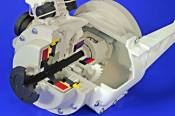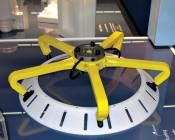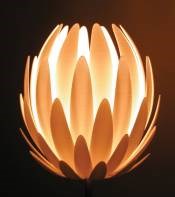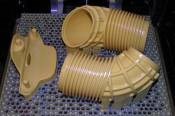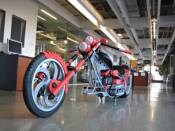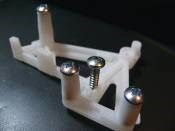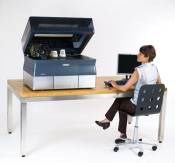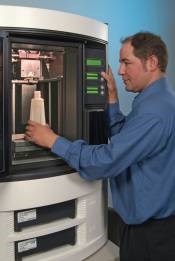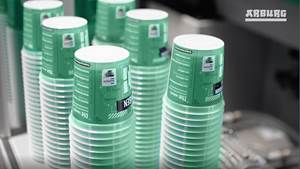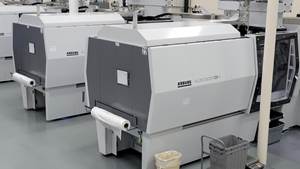Additive Manufacturing: New Capabilities for Rapid Prototypes And Production Parts
Many plastics processors are just starting to become familiar with the terms “additive manufacturing” or “additive fabrication,” which refer to a group of processes that build up parts by successively adding material, often in layers.
Many plastics processors are just starting to become familiar with the terms “additive manufacturing” or “additive fabrication,” which refer to a group of processes that build up parts by successively adding material, often in layers. These processes use a computer model of the part, typically cut into “slices,” rather than tooling. In the last couple of years, advances in additive fabrication equipment and materials make possible not only improvements in the “form, fit, and function” of so-called rapid prototypes, but also allow these processes to be used to produce a wider range of production parts. These advances have occurred across the board, from the older additive fabrication technologies of stereolithography, laser sintering, and fused deposition modeling to the newer “3D printing” technologies. Makers of these systems believe that the speed and cost efficiency of these systems will become even more attractive in this economic downturn.
The 3D printers, which emerged more than a decade ago, are the fastest-growing sector of additive fabrication. For a time, the technology was most familiarly linked with units from companies such as Z Corp., 3D Systems, and Objet Geometries, which utilize “ink-jet” type printheads to dispense droplets of material—a liquid photopolymer or a resin-based liquid binder—to build parts in layers that are cured or consolidated by a laser beam or uv lamp. However, the term “3D printer” has come to include any type of small additive fabrication system that is relatively low-cost, easy to use, and suitable for use in an office environment. These advantages have ensured their popularity, despite more limited capabilities and material choices than the high-end systems, according to Fred Fischer product marketing manager at Stratasys. This category now include the Dimension 3D printers from Stratasys that utilize its fused deposition modeling (trademarked FDM) process, which builds parts by extruding layers of a molten thermoplastic filament.
Another 3D printing technology is offered by EnvisionTec. The company’s Perfactory systems are based on the Digital Light Processing (DLP) technology of Texas Instruments, typically used in high-definition televisions and data projectors. These units do not use jets, lasers, or printheads. The newer, larger units build 3D objects in a continuous voxel (volumetric pixel) “layerless” mode, according to EnvisionTec CEO Al Siblani. The system projects a sequence of different-sized voxels (volu-metric pixels) into liquid photopolymer. A series of bitmaps projects voxels in different gray-scale light intensities to cure across the entire part at one time. The pre-assigned gray-scale value controls the depth of curing for each individual voxel. When the voxel data set is projected in any arbitrary printing direction, the entire part will be formed one voxel at a time.
The 2008 Wohlers Report, prepared annually by industry guru and consultant Terry Wohlers, identifies three segments that make up the largest use of additive fabrication technology. The biggest is consumer products and electronics, including toys, cell phones, and televisions; followed by motor vehicles—cars, pickups, and motorcycles; and then by medical and dental devices. Wohlers projects an increased use of these machines, particularly 3D printers, for product design and testing. The most popular 3D printers, according to his 2008 report, are Stratasys’ Dimension units, followed by Z Corp’s machines, both of which cost in the $20,000 to $60,000 range.
MOVE TO PARTS PRODUCTION
Although making prototypes remains the main use of additive fabrication, the technology has increasingly spread into rapid manufacturing—also termed “direct digital manufacturing” (DDM) by the Society of Manufacturing Engineers—as well as into rapid tooling. One industry projection for the future would involve the use of a single machine for the design, prototype, and finished part.
Indicative of this trend, says Wohlers, is the emergence of the industry term “bridge manufacturing,” for bridging the gap between when a part design is finished and when the part goes into production. “Suppose you need several thousand parts molded while waiting for tooling to be made. You can use a technology like laser sintering or FDM to make production parts while waiting for the production tooling,” Wohlers explains. He cites the example of Caterpillar Corp., which had to wait months to have tooling made for a new wiring-harness assembly. In the meantime, Caterpillar made several hundreds of this relatively large part with complex channels by using laser sintering. That success prompted Caterpillar to use this “bridge” approach again for a new oil-filter assembly.
Additive fabrication is being used for short-run or “bridge” production of higher-value products, where tooling is likely to be more complex, expensive, and time-consuming to produce. According to Wohlers, markets for additive fabrication of customized and/or limited-run parts have included aerospace, machinery—from off-road equipment to copiers—and consumer products such as home accessories and decorative items such as Christmas ornaments. Thus far, most of these have been laser sintered although some are FDM.
Wohlers estimates DDM to have grown over the last four years from about 4% to nearly 15% of the additive fabrication market. Stratasys reports that 36% of the company’s revenues from its high-end FDM line last year came from DDM activity in sectors such as aerospace, automotive, consumer products, and heavy industry. Says Fischer, “DDM has been the growth driver for us over the last two years—growing even faster than 3D printers. We see this trend far outpacing rapid prototyping in the future.”
EOS has done very well in DDM with its laser sintering systems, according to Wohlers. EOS states that 100% of new product development is geared toward finished-parts manufacturing. Says North American v.p. Jim Fendrick, “We are focusing on rapid manufacturing in areas like aerospace and medical. These are not critical structural parts but rather complex parts such as air ducts, which are very expensive to tool. We see the cutoff at about 5000 parts—beyond that you would do better opting for tooling and injection molding.”
One new EOS medical application of direct manufacturing with laser sintering is customized cutting guides for knee replacements, made of nylon 12. Fendrick also cites the example of Hettich GmbH, a German maker of laboratory centrifuges, which opted to laser sinter a washing-machine rotor. The product had been injection molded in 32 separate parts and required a special steel pipe to be deburred in a costly manner. The EOS laser-sintered product comprised only two plastic parts and one steel ring.
FDM EXPERIENCE
There are several things to consider when opting for DDM, including production volume, part size and complexity, and material cost. According to Wohlers, DDM is worth considering if both the part and production volume are relatively small. “Size is a factor. With small parts—say, the size of your fist—it makes sense to skip tooling, unlike a larger part like an instrument panel. DDM may be good for several hundred parts, although in some industries like medical, they are making several thousands of custom-fit parts such as hearing aids.”
Commercial custom-fit hearing-aid shells are made of photopolymer materials with either 3D Systems’ stereolithography (SLA) technology or EnvisionTec’s Perfactory 3D printing systems. EnvisionTec now claims to have about 60% of this additive fabrication market, and Siblani estimates that worldwide, Perfactory units are turning out about 600,000/month of these products.
PET bottle consultant Plastic Technologies, Inc. in Holland, Ohio, has been utilizing SLA for two and a half years to create a gripping chuck for its hand-held TorqTraQ torque-testing device (which measures the torque needed to twist off a bottle cap), owing to its high accuracy and new materials options, according to v.p. Donald Miller. PTI started using a state-of-the-art SLA unit and one of the newer photopolymers for this rapid manufacturing function rather than conventional machining to fabricate these chucks, which allow the TorqTraQ device to mate precisely with almost all closures. These are very complex parts, and the photopolymer material adheres well to the closure with no slip.
The use of color is a trend in rapid prototyping, and Z Corp. has also exploited the full-color capability of its 3D printers to enter the field of rapid manufacturing itself. Its new ZPrint center has been building colorful action figures for makers of video games such as Guitar Hero II and Spore. CEO John Kawola says customers have also used ZPrinters to make plastic tooling for short runs of about 100 units in blow molding and thermoforming.
Wohlers cautions that materials available for DDM can cost from 10 to 100 times more than typical injection molding thermoplastics. In addition, the materials’ key properties such as strength, dimensional stability over time, resistance to heat and moisture, and color stability all need careful evaluation. “We know much more about the performance of commonly used thermoplastics than we do these materials,” he notes.
Adds PTI’s Miller, “Despite the cost of these materials, the fact is that you can make a one-piece functional part that is stronger than a multi-piece injection molded part while eliminating assembly. With today’s technology, you can make more complex parts with undercuts, as the RP support materials can be dissolved away after fabrication. Other key factors to consider are how fast can you make a part, with what accuracy and repeatability, as well as the durability of these parts.”
Better materials continue to be introduced for all types of additive fabrication systems. But since thermoplastics make up most of the end-use products, laser sintering and FDM are seen to have the most potential in rapid manufacturing. Examples of notable new introductions include EOS’s PEEK material for laser sintering, and Stratasys’ addition of Sabic’s Ultem polyetherimide for FDM. Both are UL 94V-0 flame-retardant engineering thermoplastics widely used in aircraft interiors. 3D Systems has introduced new and improved photopolymers for SLA, but their long-term stability continues to be a question for many manufacturing applications, according to Wohlers.
Tom Walczak, director of engineering services at custom injection molder Dickten Masch Plastics (DMP) in Nashotah, Wis., says the firm’s Materials Lab and Technical Services Group is working with the Milwaukee School of Engineering’s Rapid Prototyping Consortium to study some of the newer RP materials and determine their mechanical characteristics at different temperatures. The tests include tensile, flexural, and instrumented impact testing both at elevated and sub-ambient temperatures. This data will be used to compare actual tested RP parts with finite-element analysis (FEA) simulation results. This comparison will help establish the actual material capabilities and design requirements so that DDM parts can be optimized for production.
MORE ON PARTS & TOOLING
As noted above, in the case of Z Corp., direct involvement of equipment makers in RP and DDM activities is becoming something of a trend. It was apparently started by Stratasys with its seven-year-old Red Eye rapid-prototyping and manufacturing center, which mostly builds prototypes but is now also doing a significant percentage of DDM parts with FDM. Wohlers foresees this trend continuing and says he would not be surprised to see companies such as EOS or 3D Systems offering similar services with their laser-sintering technologies.
Wohlers does not project major use of additive fabrication machines and materials for rapid tooling. He notes, however, that FDM and laser sintering could be used for thermoformed tooling because these processes yield parts with porosity that can be used to draw a vacuum through the tool.
DMP’s Walczak agrees with Wohlers, noting that although additive fabrication materials are improving both in mechanical abilities and price, they are still are far from most of the engineered materials used for production. “We did try creating tooling using SLS, but the technology proved not to be as robust as we needed, so we are currently using more traditional moldmaking methods with an accelerated process to produce production tools in a week or two rather than the typical 10 to 16 weeks.”
On the other hand, PTI is using Stratasys’ FDM process and its newer ABS Plus (ABS/PC) material for tooling parts in its stretch-blow molding machines. Says Miller, “These are change parts that touch the surface of the preform, and FDM speeds up our development process rather than going the typical tooling route.”
Both DMP and PTI use additive fabrication for prototypes. “The ability to quickly turn a design concept into a solid model and then into a physical part is critical in meeting today’s accelerated product development timetables, says DMPs Walczak. DMP has had an SLA 5000 unit for the last two years and has been using photopolymers that fall between PP and PC in mechanical strength. “SLA samples can be made quickly and accurately at a reasonable cost. We also offer other rapid prototyping techniques like SLS, FDM, and 3D printing through our relationships with local universities and industry partners.”
Walczak sees tradeoffs between the various techniques. He considers SLA superior in terms of dimensional stability and warpage. On the other hand, “While the SLA photopolymers are better in stiffness, they are not as good in terms of weatherability as the SLS materials.” DMP also utilizes SLS or FDM for short runs of small parts where volumes are less than 1000 pieces/yr.
PTI employs both FDM and SLA in place of injection and blow molding for some applications. Says Miller, “We select the process based on our objectives. For example, FDM offers lower material costs and faster build times. FDM enables you to get a part overnight, while the SLA process typically takes a couple of days.” With FDM, PTI produces thousands of parts for development, including bottles and other functional components, using Stratasys’ABS and ABS/PC. “We have made models that look equivalent in quality to commercial injection molded counterparts. We are able to make FDM fit-and-function parts for market testing before having to go to injection molding. We’re not trying to replace injection molding, just to speed up the development process.”
On SLA, Miller notes that there are now photopolymers transparent enough to make lenses for automotive testing, but not yet clear enough for PET bottle prototypes. “As the process and technology are fine-tuned, we are hoping the ability to create transparent prototypes will trickle down to bottle sampling in a cost-effective way.”
ThermoFab, a Shirley, Mass., thermoformer of custom plastic enclosures for computer, medical, and industrial equipment, recently used SLA to assist one of its customers in a complete redesign of its products—from vintage looks with squared corners and metal casings to contemporary designs with curves, plastics, and colors. The current project is for a printer door cover. Manufacturing engineer Lisa King says this customer chose ThermoFab due to its ability to assist in the design stage with an SLA prototype and then move to production tooling within four to seven weeks. “We have primarily used SLA, and have seen improvements in speed and finish in form-fit-function prototypes, which we then paint in colors.” says King.
3D PRINTERS UPDATE
- Stratasys’ latest addition to its Dimension line of FDM-based units is the uPrint Personal 3D Printer, a compact desktop unit with a 25 x 26 in. footprint that sells for only $15,000. It produces functional testing models from ABS Plus (ABS/PC alloy).
- Objet Geometries’ Alaris 30 is a new, lower-priced desktop (about $40,000) that’s compact (32 x 24.4 x 23 in.) and can produce complex, extremely detailed models with excellent finish up to 11.6 x 7.7 x 5.9 in. size, or many small parts simultaneously. It utilizes the same ultra-thin PolyJet Technology, which jets photopolymer in 16-micron layers as the company’s Eden line. Its two print heads use the gel-like Vero White FullCure830 photopolymer to provide accuracy within 0.1 to 0.2 mm. Four cartridges deliver up to 36 hr of unattended printing.
- Objet also added the compact model 260V to its Eden line of highly accurate 3D printers. This is the first small Objet (34.3 x 29 x 47 in.) printer that can support all of the company’s proprietary materials. It can provide 72-hr continuous printing.
- Objet’s one-year old Connex 500 is the first 3D printer to be able to fabricate parts and assemblies made of multiple materials with different physical properties, all in a single build cycle. It can print 600 x 900 dpi with a tolerance of 0.3 mm over large models, and brings development much closer to realizing the final product at an early stage, including feasibility testing and overmolding process simulation.
- New photopolymers from Objet include DurusWhite, which is said to give the milky-white look and feel of PP, and also simulates PP’s fatigue resistance to enable snap-fit and living-hinge functionality. A year ago, the company introduced TangoPlus FullCure 930, a semi-translucent elastomer with 218% elongation at break, more than double that of any other rapid-prototyping material. It’s aimed at prototypes of gaskets, seals, hoses, athletic footwear, and toys.
- Z Corp. recently introduced the largest, most automated, multicolor 3D printer on the market, claimed to have more than double the resolution of other devices at 600 x 540 dpi, and to be five to 10 times faster. ZPrinter 650 has a build size of 8 x 15 x 18 in., surpassing the two-year-old model 450 (8 x 10 x 8 in.). It also boasts better resolution, color, and vibrance.
- Z Corp. remains the only maker of 3D printers that employ full-spectrum, 24-bit color and multiple print heads to simultaneously print in multi colors. It raised the bar with model 650 by adding a dedicated black print head to the standard cyan, magenta, yellow, and clear colors. (Competing 3D printers print just one color at a time, requiring a color change for multi-colored parts.)
New materials from Z Corp. include zp131 and zp140 composites. The former is a multi-purpose material with high resolution and color accuracy for very tough fit-and-functional prototypes. The other produces bright-white models that need only be misted with tap water to reach their finished strength.
- 3D Systems introduced the ProJet CPX and CP 3000 3D printers that utilize its proprietary Multi-Jet Modeling technology, combined with new VisiJet wax build material and dissolvable wax support. These produce 100% “real wax” patterns that are designed to perform like injected wax patterns in lost-wax casting. The CP 3000 is said to be a cost-effective option for general foundry applications such as medium- to large-sized mechanical parts for engines, pneumatics, aerospace, and heavy equipment. With a large build volume of 11.75 x 7.3 x 8 in. and a single-pass print-head, it can build either a single large or multiple smaller patterns. Its part stacking and nesting software enables full utilization of the Z-direction build volume for longer unattended operation.
The dual-mode ProJet CPX is suited to producing patterns for medical instruments and devices, mechanical parts, jewelry, and collectables. Its HD high-definition mode is for high-speed, high-definition production of small to large parts with excellent surface finish; and its XHD extreme high-definition mode is said to deliver a 16-micron layer thickness for parts with the delicate fine-featured details that are common in micro-casting.
The company’s year-old ProJet HD3000 3D printer similarly offers two high-definition modes, large build volumes, and special part stacking and nesting capabilities.
As we reported last month, two recently introduced 3D printers that boast affordability and broader options for modeling include the V-Flash Desktop Modeler ($9900), the company’s first unit based on its new Film Transfer Imaging (FIT) technology; and the Pro-Jet SD 3000 that uses MJM technology to provide parts with exceptionally smooth surfaces and tiny feature detail for concept development and form/fit testing. It is particularly suited to premium consumer packaging, electronic components, and medical devices.
- EnvisionTec introduced its two larger models of Perfactory 3D printers, based on DLP technology, in the last four years. Perfactory Xede and Xtreme reportedly allow fast builds of exceptionally large 3D parts without sacrificing surface quality and accuracy. The build envelope ranges from 15 x 12 x 15 in. for Xtreme to 20 x 16 x 20 in. for Xede. The continuous, “layerless” Z build on these units is said to eliminate the part layering that is visible in other competing layer-based technologies.
These units can create models that range from conceptual to the fully functional using photopolymer materials that mimic ABS, PP, or glass-filled nylon. New introductions include Class 6 and Class 2 biocompatible materials for medical device manufacturing such as hearing aids, and nano-filled materials for high-temperature plastics applications. For example, new Nanocure RC25 has a 400 F HDT and is geared to applications requiring superior stiffness and heat resistance, such as automotive components, pump housings and impellers, wind-tunnel test parts, light reflectors, and injection molds. Newer materials also include epoxy-based photopolymers for highly accurate, zero-shrink parts, and Edent 50%-glass composite for the dental market. Other recent introductions from EnvisionTec include software and hardware designed to enhance surface quality and resolution.
LASER SINTERING NEWS
- EOS recently unveiled Eosint P 800, said to be the world’s first high-temperature system for laser sintering high-performance polymers. Up to now, engineering resins with a melting range of 428 to 725 F could not be used in this process. Based on its P 730 predecessor, the P 800 uses two 50W CO2 lasers and has a similar build volume of 27.6 x 15 x 22.9 in. Build speed is up to 1.38 in./hr, with layer thickness typically 0.005 in.
This machine can produce components from high-performance polymer powders suited to aerospace, motorsport, and medical applications that require flame-retardant, biocompatible, and easily sterilized materials. Among the first materials to be launched is PEEK HP3, which has been used to produce air ducts for commercial aircraft. This material has a tensile strength of up to 95 MPa and Young’s modulus of up to 4400 MPa. These values are up to double those for materials like nylon 12 and 11, which currently dominate the laser sintering market. Continuous-use temperature for the resin is around 500 F for electrical applications, 464 F for static mechanical performance, and 356 F for dynamic mechanical performance.
Another new material from EOS is Prime Part DC, an impact-resistant nylon 11 that can withstand high mechanical and thermal loads. It has a tensile strength of 48 MPa, elongation at break of 50%, and fuel resistance.
- 3D Systems recently introduced DuraForm PP 100 Plastic, said to be the first SLS material with the toughness and durability of polypropylene. This PP is said to produce prototypes and end-use parts for packaging, medical, and automotive markets. It has excellent chemical resistance and is said to provide excellent fatigue life in living hinges.
FDM NEWS
The latest FDM materials and equipment from Stratasys include Ultem 9085 polyetherimide (from Sabic Innovative Plastics) for use on the company’s two top additive-fabrication machines, the FDM 900mc and 400mc. Because the resin is certified for use on commercial aircraft, users can bypass a lengthy certification process. The inherently flame-retardant material has heat resistance up to 320 F.
As reported last December, other recent material introductions include PC and PC/ABS for the FDM 360mc and translucent ABS and pharmaceutical-grade (USP Class VI) PC for the FDM 400mc.
In hardware, The FDM 900mc, introduced last summer, is suitable for DDM due to its greater build-size capability of 3 x 2 x 3 ft and its high accuracy and repeatability. Smoothing Station is a new semi-automated process that is said to give FDM ABS parts a surface finish equivalent to injection molding. The unit consists of two chambers; the first treats the part for 15 to 30 sec to smooth the outer surface. The part is then moved to the second chamber, which holds the part while it cures from the initial process. Parts can be handled after 30 to 45 min and are fully cured in 12 to 18 hr or less.
SLA NEWS
- 3D Systems’ new iPro 9000 and 8000 SLA Precision Centers are said to allow production of ultra-high-definition parts with the company’s Accura Plastics photopolymers that simulate PP, ABS, PC, and other engineering resins. These units are said to produce durable parts with unprecedented surface smoothness, feature resolution, edge definition, and tolerances that rival the accuracy of CNC-machined plastic parts.
The iPro 9000 and 8000 feature ProScan, a proprietary digital scanning system with a new SteadyPower Imager that reportedly enables builds at a faster rate than any other SLA system. Build envelopes range up to 59 x 30 x 22 in.
New within the past year was 3D Systems’ Accura Greystone gray epoxy nanocomposite for SLA. It is designed for wind-tunnel testing of motorsport and aerospace parts and can also be used for tooling, automotive underhood parts, electrical insulating components, and jigs and fixtures.
- DSM Somos’ proprietary DMX-SL 100 photopolymer, introduced two years ago, is said to produce an unprecedented combination of stiffness and toughness for high-durability applications. It has the stiffness of standard ABS-type resins but with more than twice the impact strength. Gardner impact is as much as four times higher than other SLA and 3D-printing materials, the company claims. It also reportedly has up to twice the impact resistance of FDM ABS or PC and some laser-sintered nylons.
Related Content
Injection Compression Molding as Alternative to Thermoforming
Arburg will show its all-electric Allrounder 720 A press utilizing injection compression molding to create thin-wall IML cups from PP.
Read MoreAbsolute Haitian Brings Next Generation of Presses to Orlando
NPE2024: Absolute Haitian says Generation 5 of the servo-hydraulic Haitian and electric Zhafir machines lines emphasize efficiency, performance and intelligence.
Read MoreConsistent Shots for Consistent Shots
An integral supplier in the effort to fast-track COVID-19 vaccine deployment, Retractable Technologies turned to Arburg and its PressurePilot technology to help deliver more than 500 million syringes during the pandemic.
Read MoreU.S. Debut for Slimmed Down Electric Machine
NPE2024: Arburg’s debut of the 310-ton Allrounder 720 E Golden Electric extends the tonnage range of the electric series and marks the first global press premiere outside of Germany.
Read MoreRead Next
Making the Circular Economy a Reality
Driven by brand owner demands and new worldwide legislation, the entire supply chain is working toward the shift to circularity, with some evidence the circular economy has already begun.
Read MorePeople 4.0 – How to Get Buy-In from Your Staff for Industry 4.0 Systems
Implementing a production monitoring system as the foundation of a ‘smart factory’ is about integrating people with new technology as much as it is about integrating machines and computers. Here are tips from a company that has gone through the process.
Read MoreBeyond Prototypes: 8 Ways the Plastics Industry Is Using 3D Printing
Plastics processors are finding applications for 3D printing around the plant and across the supply chain. Here are 8 examples to look for at NPE2024.
Read More




